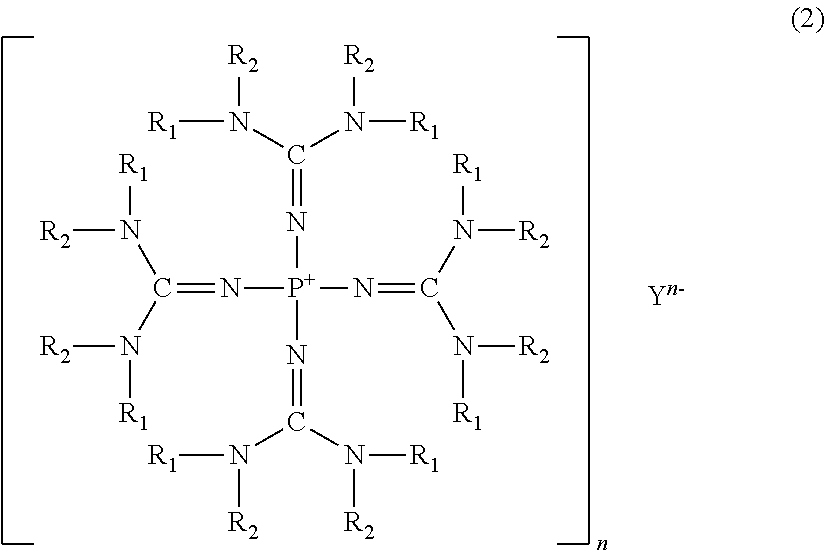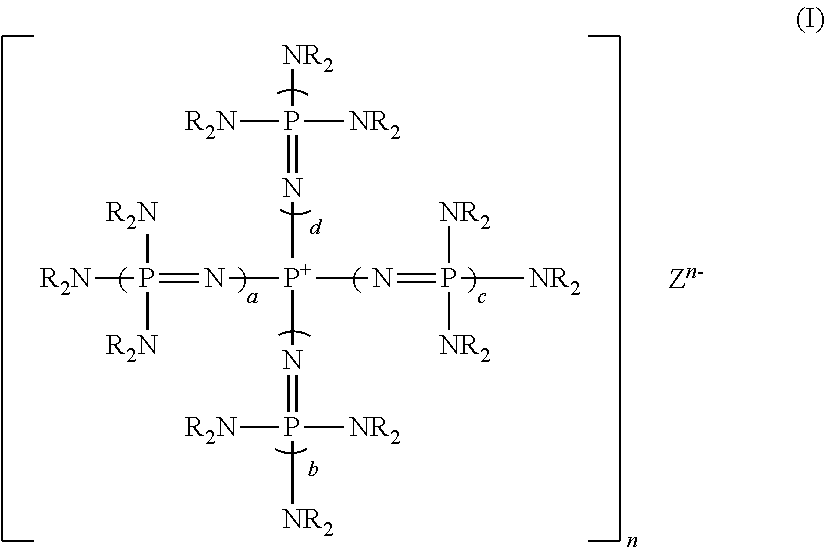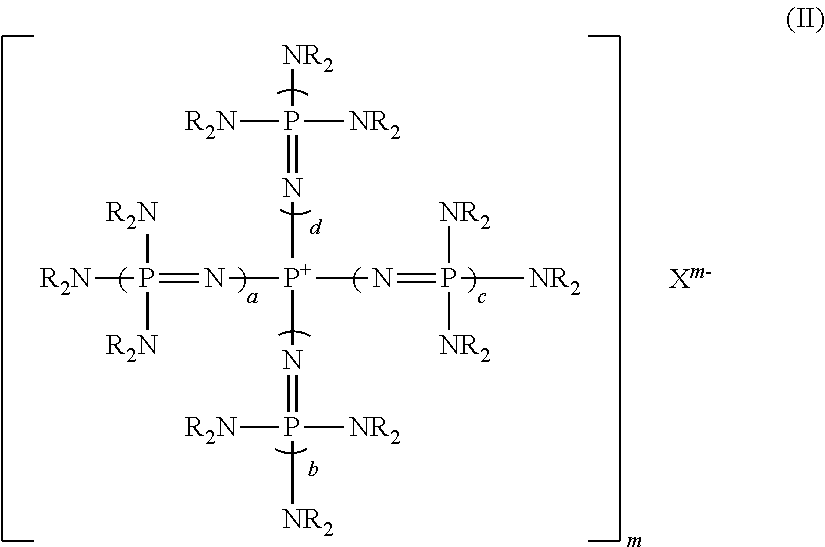Polyalkylene glycol producing catalyst, and method for producing polyalkylene glycol using same
- Summary
- Abstract
- Description
- Claims
- Application Information
AI Technical Summary
Benefits of technology
Problems solved by technology
Method used
Image
Examples
preparation example 1
[0123]Tetrakis(tetramethylguanidino)phosphonium chloride: [(Me2N)2C=N]4P+Cl− (wherein Me represents a methyl group, and the same applies hereinafter) was prepared as follows.
[0124]Into a 300 ml four-necked flask provided with a thermometer, a dropping funnel, a condenser and a magnetic stirrer, 4.01 g (10.0 mmol) of phosphorus pentachioride was introduced, and 60 ml of dehydrated toluene (manufactured by Wako Pure Chemical Industries, Ltd.) was added thereto to obtain a slurry solution. This slurry solution was immersed in a cooling bath cooled to −30° C. by dry ice-acetone to bring the internal temperature to be −30° C., and then, with stirring strongly, 22.2 g (20 mmol) of 1,1,3,3-tetramethylguanidine was dropwise added from the dropping funnel over a period of 1 hour. Stirring was continued at −30° C. for 1 hour, and then, the cooling bath was removed, and the temperature was slowly raised to room temperature. This slurry solution was further heated at 100° C. for 10 hours to obt...
preparation example 2
[0129]Tetrakis(tetramethylguanidino)phosphonium hydroxide: [(Me2N)2C═N]4P+OH31 was prepared as follows.
[0130]3.2 g (6 mmol) of tetrakis[(dimethylamino)imino]phosphonium chloride was dissolved in 100 ml of deionized water to prepare a 0.06 mol / L solution. This solution was passed through a column (diameter: 30 mm, height: 600 mm) packed with 100 ml of a hydroxy group-type anion exchange resin (AMBERLITE IRA4100H, manufactured by Organo Corporation) at room temperature at a flow rate of 300 ml / hr, and 150 ml of deionized water was further passed therethrough at the same flow rate. The effluent was concentrated and evaporated to dryness at 40° C. under 1 mmHg to obtain 3.1 g of tetrakis(tetramethylguanidino)phosphonium hydroxide: [(Me2N)2C═N]4P+OH− as white crystals. The yield was 99%.
Results of 1H-NMR measurement (deuterated solvent: CDCl3, internal standard: tetramethylsilane):
[0131]Chemical shift: 2.83 ppm (methyl group).
Results of GC-MS (FAB+) Measurement:
[0132]m / z=487 (agreed to ...
preparation example 3
[0135]Tetrakis(1,3-diisopropylimidazolidineimino)phosphonium chloride was prepared as follows.
[0136]Into a 200 ml four-necked flask provided with a thermometer, a dropping funnel, a condenser and a magnetic stirrer, 2.3 g (11 mmol) of phosphorus pentachioride was introduced, and 23 ml of dehydrated toluene (manufactured by Wako Pure Chemical Industries, Ltd.) was added thereto to obtain a slurry solution. This slurry solution was immersed in a cooling bath cooled to −30° C. by dry ice-acetone to bring the internal temperature to be −30° C., and then, with stirring strongly, 18.5 g (110 mmol) of 1,3-diisopropylimidazolidineimine was dropwise added from the dropping funnel over a period of 1 hour. Stirring was continued at −30° C. for 1 hour, and then, the cooling bath was removed, and the temperature was slowly raised to room temperature. This slurry solution was further heated at 100° C. for 10 hours to obtain a white slurry solution. After cooling to room temperature, the slurry wa...
PUM
| Property | Measurement | Unit |
|---|---|---|
| Substance count | aaaaa | aaaaa |
| Acid value | aaaaa | aaaaa |
| Fraction | aaaaa | aaaaa |
Abstract
Description
Claims
Application Information
 Login to View More
Login to View More - R&D
- Intellectual Property
- Life Sciences
- Materials
- Tech Scout
- Unparalleled Data Quality
- Higher Quality Content
- 60% Fewer Hallucinations
Browse by: Latest US Patents, China's latest patents, Technical Efficacy Thesaurus, Application Domain, Technology Topic, Popular Technical Reports.
© 2025 PatSnap. All rights reserved.Legal|Privacy policy|Modern Slavery Act Transparency Statement|Sitemap|About US| Contact US: help@patsnap.com



